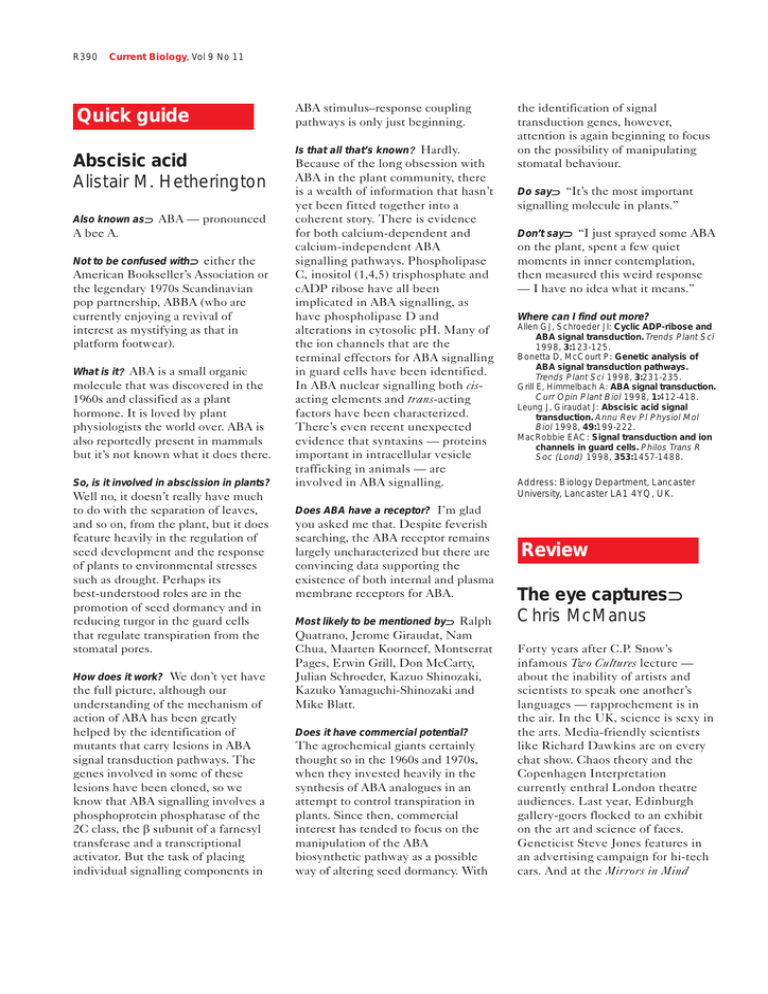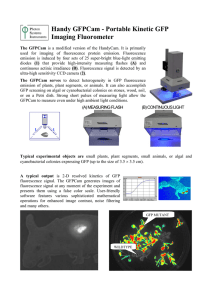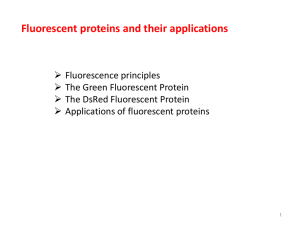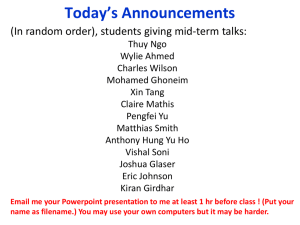Quick guide Abscisic acid
advertisement

R390 Current Biology, Vol 9 No 11 Quick guide Abscisic acid Alistair M. Hetherington Also known as… ABA — pronounced A bee A. Not to be confused with… either the American Bookseller’s Association or the legendary 1970s Scandinavian pop partnership, ABBA (who are currently enjoying a revival of interest as mystifying as that in platform footwear). What is it? ABA is a small organic molecule that was discovered in the 1960s and classified as a plant hormone. It is loved by plant physiologists the world over. ABA is also reportedly present in mammals but it’s not known what it does there. So, is it involved in abscission in plants? Well no, it doesn’t really have much to do with the separation of leaves, and so on, from the plant, but it does feature heavily in the regulation of seed development and the response of plants to environmental stresses such as drought. Perhaps its best-understood roles are in the promotion of seed dormancy and in reducing turgor in the guard cells that regulate transpiration from the stomatal pores. How does it work? We don’t yet have the full picture, although our understanding of the mechanism of action of ABA has been greatly helped by the identification of mutants that carry lesions in ABA signal transduction pathways. The genes involved in some of these lesions have been cloned, so we know that ABA signalling involves a phosphoprotein phosphatase of the 2C class, the β subunit of a farnesyl transferase and a transcriptional activator. But the task of placing individual signalling components in ABA stimulus–response coupling pathways is only just beginning. Is that all that’s known ? Hardly. Because of the long obsession with ABA in the plant community, there is a wealth of information that hasn’t yet been fitted together into a coherent story. There is evidence for both calcium-dependent and calcium-independent ABA signalling pathways. Phospholipase C, inositol (1,4,5) trisphosphate and cADP ribose have all been implicated in ABA signalling, as have phospholipase D and alterations in cytosolic pH. Many of the ion channels that are the terminal effectors for ABA signalling in guard cells have been identified. In ABA nuclear signalling both cisacting elements and trans-acting factors have been characterized. There’s even recent unexpected evidence that syntaxins — proteins important in intracellular vesicle trafficking in animals — are involved in ABA signalling. Does ABA have a receptor? I’m glad you asked me that. Despite feverish searching, the ABA receptor remains largely uncharacterized but there are convincing data supporting the existence of both internal and plasma membrane receptors for ABA. Most likely to be mentioned by… Ralph Quatrano, Jerome Giraudat, Nam Chua, Maarten Koorneef, Montserrat Pages, Erwin Grill, Don McCarty, Julian Schroeder, Kazuo Shinozaki, Kazuko Yamaguchi-Shinozaki and Mike Blatt. Does it have commercial potential? The agrochemical giants certainly thought so in the 1960s and 1970s, when they invested heavily in the synthesis of ABA analogues in an attempt to control transpiration in plants. Since then, commercial interest has tended to focus on the manipulation of the ABA biosynthetic pathway as a possible way of altering seed dormancy. With the identification of signal transduction genes, however, attention is again beginning to focus on the possibility of manipulating stomatal behaviour. Do say… “It’s the most important signalling molecule in plants.” Don’t say… “I just sprayed some ABA on the plant, spent a few quiet moments in inner contemplation, then measured this weird response — I have no idea what it means.” Where can I find out more? Allen GJ, Schroeder JI: Cyclic ADP-ribose and ABA signal transduction. Trends Plant Sci 1998, 3:123-125. Bonetta D, McCourt P: Genetic analysis of ABA signal transduction pathways. Trends Plant Sci 1998, 3:231-235. Grill E, Himmelbach A: ABA signal transduction. Curr Opin Plant Biol 1998, 1:412-418. Leung J, Giraudat J: Abscisic acid signal transduction. Annu Rev Pl Physiol Mol Biol 1998, 49:199-222. MacRobbie EAC: Signal transduction and ion channels in guard cells. Philos Trans R Soc (Lond) 1998, 353:1457-1488. Address: Biology Department, Lancaster University, Lancaster LA1 4YQ, UK. Review … The eye captures… Chris McManus Forty years after C.P. Snow’s infamous Two Cultures lecture — about the inability of artists and scientists to speak one another’s languages — rapprochement is in the air. In the UK, science is sexy in the arts. Media-friendly scientists like Richard Dawkins are on every chat show. Chaos theory and the Copenhagen Interpretation currently enthral London theatre audiences. Last year, Edinburgh gallery-goers flocked to an exhibit on the art and science of faces. Geneticist Steve Jones features in an advertising campaign for hi-tech cars. And at the Mirrors in Mind Magazine exhibition at the National Gallery last year, hard-nosed scientists and art historians had a joint study day. The Wellcome Trust, the world’s largest medical research charity, has recently been using some of its money to encourage collaboration of scientists and artists, through the Sci~Art competition. It’s a laudable aim but the cynical, including this runner-up, suspect some winning entries have more to do with artists representing science than with serious science. I could well imagine a winning entry that had a grandmother, mother and daughter team of knitters collaborating with the neighbourhood physicist and video artist to explore quantum chromodynamics in wool. The risk is that science-with-art does not acknowledge that most real science is about difficult ideas, hard thinking, messy data and the occasional lucky break. My expectations were therefore not high when I went to The Painter’s Eye, a Sci~Art sponsored exhibition at the National Portrait Gallery in London. I was wrong. The exhibition is fascinating, and scientifically and artistically sophisticated. Humphrey Ocean, a portrait painter, was filmed drawing portraits while wearing an eye-movement tracker, using a pencil whose three-dimensional position was continually mapped, and while Humphrey Ocean’s Luke 2 drawing (left) and the hand movements that created it (right). All movements of the pencil within one centimetre of the paper are shown in black. The hand was making many more movements near the paper than were required just to draw the lines. inside an fMRI scanner. Meticulous editing has generated a beautiful video of the emerging portrait overlaid with the artist’s foveal fixations on the subject. Every pencil movement is recorded, including many in which the pencil is a few millimetres above the surface of the paper while the artist, who has a very deliberate and controlled technique, practices the mark he will eventually make (see Figure). And, with a pleasing circularity, the hand movement data have been used to create a sculpture that is a piece of art in its own right. Martin Moore’s wire sculpture traces out the three-dimensional movements of Ocean’s pencil tip, such that the flat portrait itself seems to hang eerily in space. Perhaps least interesting are the fMRI data which, unsurprisingly, show increased frontal activity in the professional artist compared with inexperienced controls, where posterior, visual cortical activity predominates. The reason is clear from the artist’s own insights: “I’m sure of what I am seeing, I’m not sure what I’m going to do about it. So I make a decision. The final result is made up of a great many decisions.” As with most experts, sensory, motor and cognitive skills are mostly automatized, leaving high-level executive decisions to be made by the frontal lobes of the brain. The exhibition is summed up in the four display captions: “The eye captures; the brain processes; the hand implements; the eye evaluates.” The first three are beautifully elucidated. Of the latter, sadly, all is silence. What happens when the artist tries out good and bad versions of a line? Does a picture composed of chosen lines differ aesthetically from one made of rejected lines? Sadly, the exhibition is too restricted to neuroscience and to impressive but overly technical plots and coloured scans that would probably baffle most visitors. Cognitive psychology and R391 experimental aesthetics could have helped make use of the wonderful data for understanding the crucial question of how an artist makes a truly good portrait. Address: Department of Psychology, University College London, Gower Street, London WC1E 6BT, UK. The Painter’s Eye is at the National Portrait Gallery in London until 13 June 1999. But you don’t necessarily need to visit the exhibition in person to get a good grasp of the technical material. The National Portrait Gallery has published a detailed catalogue (£1.00) and an excellent video (£14.99). It’s also worth visiting the associated website http://www.physiol.ox.ac.uk/~rcm/pem Correspondence Red GFP and endogenous porphyrins Andrea Sacchetti*, Valeria Cappetti*, Carlo Crescenzi*, Nicola Celli†, Domenico Rotilio† and Saverio Alberti* The finding that green fluorescent protein (GFP) can ‘turn red’ on photoactivation [1,2] has stirred considerable interest. The fluorescent properties of a chromophore, however, are rigidly determined by its molecular structure [3] and the mechanism of a GFP switch to different excitation and emission wavelengths [1,2], and from short-lived to long-lived fluorescence [1] remains to be clarified. We observed red fluorescence emission in Escherichia coli MG-T7 expressing the wild-type, S65T, Bex1 Current Biology, Vol 9 No 11 (b) 1 Relative abundance (%) (c) 100 75 50 25 2 [M+H]+ 2.39x107 831 cps [M+Na]+ 853 [2M+H]+ 1661 0 20 0 40 0 60 0 80 10 0 0 12 0 0 14 0 0 16 0 0 18 0 00 0 Current Biology Mass/charge ratio (atomic mass units) (a) Green to red fluorescence conversion in bacterial colonies. MG-T7 cells expressing Vex1-GFP were plated on LB–IPTG plates 3 days (left) or 1 day (right) before observation. (b) SDS–PAGE analysis of GFP and of the red fluorochrome. Lane 1, red fluorochrome; lane 2, Vex1-GFP. The plate (a) and gel (b) are illuminated with 369 nm light. (c) ESI-MS spectrum of the red fluorochrome. The masses shown correspond to the red chromophore bound to a hydrogen ion, to a sodium ion and as a dimer bound to a sodium ion. The number of events analysed during the MS run was 2.39×107. or (most intensely) Vex1 varieties of GFP (Figure 1a) [4–6]. Consistent with previous findings [1,2], the shift toward a red fluorescence was observed on prolonged growth in a low-oxygen environment [1,2], for example, in non-shaking liquid cultures or spreading out from the middle of large bacterial colonies. Small amounts of the red chromophore were produced by wild-type bacteria, but its production was considerably increased by GFP overexpression. The red shift was accelerated by, but was not strictly dependent on, photoactivation (compare Figure 1a with Figure 2b). We purified the red chromophore from lysates of GFP-expressing cells by extraction in phenol and chloroform, digestion with DNase and proteinase K and precipitation in ultraviolet (UV) illumination (340–380 nm) [2], or with blue light (460-500 nm) [1], which corresponds closely with the excitation peaks of porphyrins or chlorins (Figure 2c) [10,11]. The red emission of photoconverted GFP shows a peak at 600–605 nm [1], in close parallel to chlorin emission (Figure 2c) [10–12], and fluorescence characteristic of a tetrapyrrolic structure is routinely detected at 608 nm in most bacterial strains. Little correlation was found Figure 2 (a) 100 Fluorescence intensity (a) ethanol (Figure 1b). The single peak of fluorescent chromophore was purified to homogeneity by reversephase high-performance liquid chromatography and verified by electrospray-ionisation mass spectrometry (ESI-MS; Figure 1c). Analysis of this substance demonstrates that it is a porphyrin. Its fluorescence absorption and emission spectra are very similar to those of protoporphyrin IX (Figure 2a) and are essentially identical to those of uroporphyrin I and III (data not shown). SDS–PAGE analysis indicates that the red chromophore is much smaller than GFP (Figure 1b) and ESI-MS demonstrates that it has a molecular weight of 830 Da (a mass/charge ratio of 831 amu; Figure 1c), which is essentially the same as that of uroporphyrin III; GFP has a molecular weight of 27 kDa. Other dissimilarities between the red chromophore and GFP are the resistance of the red chromophore to acid hydrolysis, Edman degradation, boiling, exposure to SDS, to pH 0 and to pH 14. ESI-MS fragmentation analysis failed to identify fragments corresponding to single amino acids or short peptides, thus ruling out a structural relationship with GFP. On the other hand, this analysis demonstrated a fragmentation pattern very similar to that of uroporphyrin III (our unpublished data). The fluorescence lifetime of the red chromophore, measured by phase and modulation fluorometry [7], is 15.5 ± 0.1 ns, which is considerably longer than that of conventional fluorescent chromophores, but is remarkably close to that of porphyrins, for example, protoporphyrin IX has a fluorescence lifetime of 13.7 ± 0.3 ns (see also [8]). Porphyrins or porphyrin derivatives like chlorins [9,10] seem, in general, to account for ‘GFP photoactivation’ [1,2]. Porphyrin-like compounds are ubiquitous [10]. ‘GFP photoactivation’ [1,2] is obtained with highest efficiency by 50 0 300 400 500 600 Wavelength (nm) 700 400 500 600 Wavelength (nm) 700 400 500 600 Wavelength (nm) 700 (b) 100 Fluorescence intensity Figure 1 (c) 50 0 300 100 Fluorescence intensity R392 50 0 300 Current Biology Fluorescence spectra. (a) Excitation (green and black) and emission (red and blue) spectra of the red chromophore (green and red) and of protoporphyrin IX (black and blue). Note that the spectra of the red chromophore are also very similar to those of uroporphyrin III (data not shown). (b) Emission spectra of a bacterial lysate exposed to successive cycles of photoactivation with UV light (5 min each). Black, 1st cycle; blue, 2nd cycle; red and green, 3rd cycle in the presence (red) or absence (green) of protease inhibitors. Similar results have been obtained by photoactivating with blue or white light (not shown). (c) Excitation (green) and emission (red) spectra of lysates of bacteria overexpressing the cysG-encoded chlorin, siroheme synthase [10]. Magazine between red emission and the GFP variant expressed, which rules out a correlation with specific GFP chromophores. An interesting exception is that UV-excited wildtype and Vex1 GFP variants give more red fluorescence than other variants [2,5,6], because they may interfere with excitation of porphyrin or chlorin more efficiently. The photoactivated red-emitting compound seemed to be stable for extended periods of time (≥ 24 hours), and no evidence of reversion to green-emitting states was reported [1,2], consistent with the production of a stable, or new, molecular species. The most pronounced photoactivation was obtained after 20 minutes of continuous illumination [1], a timescale consistent with proteolysis of GFP (Figure 2b; see below). A red emission is detectable before photoactivation of GFP ([2] and our unpublished observation), so GFP is not strictly necessary for the ‘red photoconversion’ to occur. The emission of red fluorescence, however, is enhanced by GFP expression [2] and correlates with the amount of synthesized GFP molecules [1,2]. The possibility of a physical interaction between porphyrins or chlorins and GFP, suggested by these results, is of interest. The interaction might increase the red fluorescence emission by energy transfer [13] and/or might quench absorption of light because of the partially overlapping excitation spectra of GFP and tetrapyrroles [2,5,10]. Copurification of a porphyrin precursor with GFP would explain the red photoactivation that is observed in purified GFP fractions [1]. The red photoconversion is favored, however, by concomitant illumination and proteolysis of GFP (Figure 2b). Thus, an interesting possibility is that GFP might photochemically activate oxygen to create reactive oxygen radicals [9,14]. GFP has a tight molecular structure that is scarcely permeable to oxygen. A GFP that was partially unfolded, because of proteolytic damage or photoactivation for example, would, however, be more permeable to oxygen and oxygen radicals. Moreover, a partially proteolysed GFP would be able to absorb light but would be much less efficient in releasing it as fluorescence if it released light at all, and this could provide energy for activation of oxygen. The occurrence of this phenomenon in an oxygen-deprived environment might prevent excessive oxidation of porphyrin to nonfluorescent forms. The chemical reactivity of oxygen radicals is consistent with the timescale of red photoactivation, with the ‘localized’ production seen by Elowitz et al. [1], and with an interaction with oxygen radical scavengers. A GFP–porphyrin interaction is of interest and might permit novel applications such as in bacteria tracking studies or quantitation of intermolecular interactions [13,15]. 7. 8. 9. 10. 11. 12. 13. Acknowledgments This work has been supported by the Italian Association for Cancer Research (AIRC) and the Italian National Research Council (CNR — Convenzione Consorzio Mario Negri Sud). We thank T. Parasassi and F. Lorenzini for help during this work, C.A. Roessner for supplying the cysG gene, M. Anderson and L.A. Herzenberg for discussion. 14. 15. R393 Gratton E, Limkeman M: A continuously variable frequency cross-correlation phase fluorometer with picosecond resolution. Biophys J 1983, 44:315-324. Postnikova GB, Yumakova EM: Fluorescence study of the conformational properties of myoglobin structure. 3. pH-dependent changes in porphyrin and tryptophan fluorescence of the complex of sperm whale apomyoglobin with protoporphyrin IX; the role of the porphyrin macrocycle and iron in formation of native myoglobin structure. Eur J Biochem 1991, 198:241-246. Dayan FE, Duke SO, Faibis V, Jacobs JM, Jacobs NJ: Horseradish peroxidasedependent oxidation of deuteroporphyrin IX into chlorins. Arch Biochem Biophys 1998, 351:27-34. Roessner CA, Scott AI: Fluorescencebased method for selection of recombinant plasmids. Biotechniques 1995, 19:760-764. Stryer L: Biochemistry, 3rd edn. New York: WH Freemen and Company; 1988. Warren MJ, Stolowich NJ, Santander PJ, Roessner CA, Sowa BA, Scott AI: Enzymatic synthesis of dihydrosirohydrochlorin (precorrin-2) and of a novel pyrrocorphin by uroporphyrinogen III methylase. FEBS Lett 1990, 26:76-80. Mahajan NP, Linder K, Berry G, Gordon GW, Heim R, Herman B: Bcl-2 and Bax interactions in mitochondria probed with green fluorescent protein and fluorescence resonance energy transfer. Nat Biotechnol 1998, 16:547-552. Dayan FE, Rimando AM, Duke SO, Jacobs NJ: Thiol-dependent degradation of protoporphyrin IX by plant peroxidases. FEBS Lett 1999, 444:227-230. Griffin BA, Adams SR, Tsien RY: Specific covalent labeling of recombinant protein molecules inside live cells. Science 1998, 281:269-272. References 1. Elowitz MB, Surette MG, Wolf PE, Stock J, Leibler S: Photoactivation turns green fluorescent protein red. Curr Biol 1997, 7:809-812. 2. Sawin KE, Nurse P: Photoactivation of green fluorescent protein. Curr Biol 1997, 7:R606-R607. 3. Palm GJ, Zdanov A, Gaitanaris GA, Stauber R, Pavlakis GN, Wlodawer A: The structural basis for spectral variations in green fluorescent protein. Nat Struct Biol 1997, 4:361-365. 4. Studier FW, Rosenberg AH, Dunn JJ, Dubendorff J: Use of T7 RNA polymerase to direct expression of cloned genes. Methods Enzymol 1990, 185:60-89. 5. Anderson MT, Tjioe IM, Lorincz MC, Parks DR, Herzenberg LA, Nolan GP: Simultaneous fluorescence-activated cell sorter analysis of two distinct transcriptional elements within a single cell using engineered green fluorescent proteins. Proc Natl Acad Sci USA 1996, 93:8508-8511. 6. Heim R, Tsien RY: Engineering green fluorescent protein for improved brightness, longer wavelengths and fluorescence resonance energy transfer. Curr Biol 1996, 6:178-182. Addresses: *Unit of Experimental Oncology, Department of Cell Biology and Oncology, †’Gennaro Paone’ Center of Environmental Health, Istituto di Ricerche Farmacologiche Mario Negri - Consorzio Mario Negri Sud, 66030 Santa Maria Imbaro (Chieti), Italy. E-mail: alberti@cmns.mnegri.it The editors of Current Biology welcome correspondence on any article in the journal, but reserve the right to reduce the length of any letter to be published. All Correspondence containing data or scientific argument will be refereed. Items for publication should either be submitted typed, double-spaced to: The Editor, Current Biology, Current Biology Publications, 34–42 Cleveland Street, London W1P 6LE, UK, or sent by electronic mail to cbiol@current-biology.com







